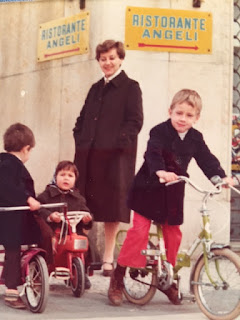 |
| The summer house taken from the meadow. |
On August 2, 2015, I posted a description of our summers in La Chapelle St. Sépulcre, France at the summer home of my in-laws. Let me repeat the first few paragraphs to set the scene.
“La Chapelle St.-Sépulcre is a tiny village about 80 kilometers south of Paris near Montargis in the Loiret. Montargis is known as the Venise du Gatinais due to its many canals.
The house and its outbuildings were once the hunting lodge of Vincent’s great-grandfather. The walls were two feet thick and kept the house warm in winter and cool in summer. The main building was near the road, but was separated by a high iron fence and tall bushes. Behind the house, to the South was a large meadow bordered by woods. At the time of the Allied Invasion this meadow was filled with the tents and campfires of the American troops chasing down the Nazis
 |
| Back row: Hubert, Vincent, me, Laurence, Mère, Martine. Front row: Kristin, Marie-Juliette, Jérôme, Charles, Olivier, Priscille and Christopher. |
We were often there with my sister-in-law, Laurence and her 2 little boys, Jérôme and Olivier. After breakfast the kids disappeared into the woods and played for hours. There were no telephones, no TVs, few toys: just their imaginations, sticks, pine cones, leaves and flowers. Laurence, Mère (my mother-in-law) and I spent hours just talking. We gossiped about relatives and friends, discussed the children, the Catholic Church, French politics, Art, books and fashion. You name it, we discussed it.
 |
| Marie-Juliette, Christopher, Jérôme, Charles and Olivier. |
Depending on who was in residence the sleeping arrangements varied. For a summer or two we had all four boys in one bedroom. Needless to say, bedtimes were a trial. At first there was a lot of giggling, throwing of pillows and eventually some crying. Then one of the adults would go in and lay down the law. Eventually we found that giving each child an Asterix or Tintin comic book would settle them down before lights out. Are you familiar with these series? In France the society at large knows every episode and character in these books. Here are some titles translated into English.
 |
| Would you like to be in charge of putting these rascals to bed? |
Relatives and acquaintances with nearby summer homes would come to play tennis and have tea in the afternoon. There were trips to nearby Montargis to go to the swimming pool or walks in the woods. Sometimes we drove to a fish hatchery to purchase a slippery, shiny trout for lunch.
 |
| Marie-Juliette, the reigning queen. |
 |
| Charles and Chris loved this tractor. |
One night Mère made rice pudding for dessert. The children took one bite and pushed it away. None of them wanted any. So Mère scooped the remainder into a charlotte mold. The next night we unmolded the rice pudding and covered it with chocolate sauce. The kids were excited at the thought of chocolate cake. They dug right in but when they realized they’d been duped their faces fell like little Pierrots. I wish I’d had a cell phone to take their picture. Laurence, Mère and I laughed till we cried.
A last memory: Vincent was the eldest son followed by his brothers Etienne and Denis and his sister Laurence. At the time of this story, Vincent, Etienne and Laurence were married. We were all on hand when Denis brought his fiancée, Ines, to La Chapelle for lunch for the first time. Sometimes conversation got a little raucous between Vincent and his brothers. But that day we were told to be on our best behavior.
Everything went well until the cheese course. Laurence had purchased a special cheese with a creamy interior. She made sure to remove it from the fridge before the luncheon began so it would be soft. When it was time for the cheese course, we each served ourselves to a slice of cheese and passed the bread. While we made polite conversation, Ines let out a little screech. She was looking at the creamy interior of the cheese that had pooled on the plate. It was alive with little worms who were swimming around. Quickly my father-in-law grabbed the bottle of apple brandy he produced with the apples in the orchard. It was about 150 proof. We all drank a small glass. The thought was the worms would never survive a tsunami of brandy.





























